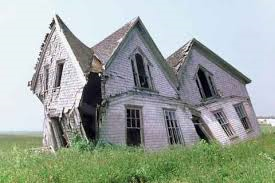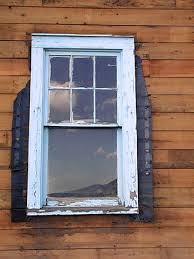COMMITTED TO AN OLD HOUSE
by Tracey Timonere (both a neighbor and restorer of old windows)
If you are reading this, it’s likely that you live in – and maybe even love – an old house. The more I learn about these incredibly enduring structures, the more committed I become to them. The other day I was browsing wavyglass.org, a site for old house lovers, and came across a topic that leads me to believe that some people think one should be committed as in institutionalized when one lives in a historic home. The question asked on the discussion forum was, “What is the worst thing someone has said about your old house?” The answers were funny yet very telling. Perhaps you will recognize some of these…
“Well, at least it’s got new windows”
“Why are you buying this !@#$ hole?”
“Why don’t you just take all this wood out?”
“Why not vinyl side the house?”
“I’d just tear it down and build a new one.”
“Aren’t you finished yet?”
“Well, it’s nice until you can afford something better in the town where you work.”
“Why would you want to live there?”
“Oh, I could never live there, I would be afraid to sleep.”
From dad: “What you need to do is slap some cheap paint on it and clean it up and sell it for cash to a bunch of druggies…..they like dumps like this out in the middle of nowhere.”
“You should have a Halloween party at your house because it looks like a haunted house.”
From realtor: “You DO realize that this was priced for the land value alone, right?”
“Have you considered calling the Mike Holmes show? I’m soooooo sorry for you…”
“Good luck.”
“I think you’re out of your !@# damned mind!”
“Why fix the plaster walls just install drywall right over it.”
“You should really take those push button light switches out.” Me: “We actually installed these ourselves.”
“You could split this up and rent it out and get your money back in no time, it wouldn’t cost much to do.”
“This house is going to fall down around you if you aren’t careful.”
“At some point you’ll have to replace these windows because the only people that know how to fix them are all dying.”
As a relatively young (and not dying as far as I know) historic window professional, that last one is my favorite. But there is some truth to it. According to University of Florida Professor of Historic Preservation Morris “Marty” Hylton, “The loss of craftspeople experienced in historic building materials and techniques is directly related to the steady erosion of traditional systems of training.” These societal and economic changes and their impact on the traditional building trades have occurred over several generations, and it will take several generations to reverse the trend. J. Brian Blundell, past managing director of the Preservation Trades Network, notes that there has been some growth and improvement in the field of preservation education in recent years citing the successes of the first 4-year preservation technology degree offered at the American College of the Building Arts. The school in Charleston, South Carolina offers degrees in six building arts including stone, iron, masonry, timber framing, carpentry, and plaster.
The sentiments these old house lovers have experienced and came together to share on the web are reflective of a long-term societal shift in values toward the mass produced, efficient, disposable, and/or maintenance-free. Thankfully, there are those of us that don’t mind doing a little maintenance, or don’t mind paying for the privilege to live in and maintain an old home. As 19th century author Isabel La Howe Conant once wrote, “He who loves an old house never loves in vain.”
When it comes to maintaining that old home, there are many resources you can look to for information and advice such as that on wavyglass.org. But when you need a professional, where do you find one? How do you know he or she will be skilled in their trade? What should/will it cost? These questions can loom in the historic homeowner’s mind (and wallet) until that rotted sill demands your attention and by then it can be too late. Building professionals call this deferred maintenance and such procrastination can sound the death knell for old things. When homeowners become knowledgeable about preservation technology, more old buildings and their unique features may not only be saved, but may flourish for many more years to come.
As inhabitants of historic homes, I believe we should think of ourselves as stewards rather than owners of these lasting tributes to craftsmanship. After all, your house was here before you were born and will likely remain well beyond. Given that so few things are built to last so long, don’t we owe it to the architects, builders, and even original owners of these historic places some of our time and resources to maintain these utilitarian works of art? No matter what “they” may say, I certainly think so.
As a doctoral student at the University of Florida, I am conducting research on the role that social media can play in the informal education of historic preservation. One aspect of preservation has remained consistent throughout its relatively brief history: it is an intensely grass-roots movement in which the real protective power is found at the local level. By coming together as community to share our experiences, resources, ideas, and even elbow grease to repair and maintain homes in the East and South Lake Morton neighborhoods, we can all do our part to tame the teardown trend. Connecting through this newsletter, the Internet, or however it’s done is important to the cause as we simply can’t do it alone.
While it may seem more than a little ironic that emerging technologies such as Facebook can help to foster preservation efforts, I have seen it in action. Recently, a group of local preservation experts came together to volunteer their time at the Baker house in Wildwood, Florida. Literally surrounded by this beautiful 1880s home is the retirement community known as the “Villages,” a.k.a. Disney for Adults. Regardless of how you may feel about the Villages project, the Baker house is both a literal and metaphorical holdout against the ravages of new construction. Using their Facebook pages, these restoration professionals recruited a small army of participants willing to pay for the pleasure of learning how to restore double hung windows. By the end of the weekend, the entire bottom floor of very large, old wood windows had been re-glazed and the mechanics revitalized. Everyone left with a sense of purpose and of belonging to a community. The best part is that each of these historic homeowners went home with plans to restore their own windows, equipped with the proper knowledge to do so. Gaps in knowledge or memory are filled through the ongoing support offered to them in the virtual community of practice in historic preservation.
It has been said that the greenest building is one that is already built. Conservation is an important aspect of the preservation movement and is the one that keeps me going when the going gets, well, termite poopy. If you are still reading this, I know you are with me on this one. To fully capture the value of the existing building stock requires merging two disciplines: historic preservation and green building. It requires an understanding of how to respect and renew what is already here and a vision for where and how to transform the legacy of the past into the promise of tomorrow. But if you just want your old wood windows repaired, that’s ok too…just look me up on Facebook.



